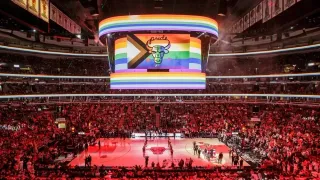
Nov 17
Three’s Company, Queer’s a Crowd: How LGBTQ+ Throuples Are Rewriting the Rules of Love
READ TIME: 4 MIN.
For decades, the LGBTQ+ community has been a vanguard of social change, pushing the boundaries of who gets to love whom—and how. Now, as the rainbow flag flies higher than ever, a new relational revolution is taking center stage: throuples. These dynamic partnerships of three are stepping into the spotlight, inviting us all to unlearn the old scripts and imagine what it means to build families that fit our lives, not just the mold.
From TikTok confessionals to viral wedding photos, throuples are everywhere you look. It’s not just about breaking taboos; it’s about the joy (and sometimes the chaos) of building something deeply authentic. “Love doesn’t have to fit into a box, and neither do we,” says Alex, a nonbinary artist from Brooklyn who shares their life with two partners. “Our throuple isn’t just a relationship—it’s a home.”
While polyamory isn’t exclusive to queer folks, LGBTQ+ communities have long been at the forefront of challenging relationship norms. Recent research underscores just how common non-monogamous structures are, especially among younger queer people. In a 2025 study, more than a quarter of LGBTQ+ youth with relationship experience identified as having engaged in consensual non-monogamy—far above national averages for different-sex peers .
Why the surge in visibility? It’s partly generational: younger LGBTQ+ people are more likely to question inherited norms about love, monogamy, and family. The legacy of fighting for the right to define our own relationships—whether through marriage equality or the celebration of chosen family—has primed a new wave of queer folks to build connections that center consent, communication, and mutual respect.
“Polyamory has always existed in the margins of queer culture,” says Dr. Samira Alvarez, a sociologist specializing in LGBTQ+ studies. “But social media and increased legal recognition of same-sex relationships have created space for throuples to be visible, vocal, and proud.”
Throuples may be trendy, but they aren’t for the faint of heart. Navigating love in threes demands a toolkit that would make any relationship therapist swoon: radical honesty, clear boundaries, and a whole lot of intentional communication.
“For us, it’s not just about having two partners—it’s about building systems of care that work for our unique needs,” explains Jordan, who lives with his two boyfriends in Chicago. “Consent isn’t a buzzword; it’s our foundation. If one of us isn’t comfortable, we all talk it out—sometimes for hours. But isn’t that what queer love is about? Making your own rules, together.”
Experts echo the sentiment. Whether it’s managing jealousy or negotiating time together, equality and transparency are non-negotiable. “In throuples, everyone’s needs and voices have to be honored,” says Dr. Alvarez. “That’s both the challenge and the beauty.”
While marriage equality has transformed the landscape for LGBTQ+ couples—over 820,000 married same-sex couples now live in the U.S., a figure that has doubled since Obergefell v. Hodges in 2015 —legal recognition of throuples remains a distant dream. For now, three-person unions exist in a gray area, celebrated in private but mostly unrecognized by state or federal law.
Still, visibility matters. Public celebrations of throuple love—from social media posts to Pride parades—are challenging the mononormative gaze. And it’s not just about adult romance: many throuples are raising children, building households, and navigating the joys and messes of queer family life.
“We get questions all the time about who’s the ‘real parent’ or how we make it work,” says Priya, a bisexual woman parenting with her two partners in San Francisco. “But our kid just knows they’re loved—by three parents who adore them. Isn’t that what counts?”
The rise of throuples is sparking heated (and often hilarious) debates in queer spaces and beyond. On Twitter, jokes about “the group chat” being a third wheel compete with earnest discussions about polyamory’s place in LGBTQ+ history. Mainstream media is catching up, with shows and films exploring triads and polycules with more nuance than ever.
But for many, the stakes are deeply personal. Visibility means validation—but it also means scrutiny. Throuples report facing everything from awkward questions (“So, do you all sleep in one bed?”) to outright discrimination in housing, healthcare, and legal matters.
“If there’s one thing queer people know, it’s how to create community where none exists,” says Alex. “Being in a throuple isn’t always easy, but it’s ours. And that’s powerful.”
As LGBTQ+ folks continue to expand the possibilities of love and family, throuples are at the vanguard of a broader movement: one that insists relationships should be crafted by, and for, the people in them. The challenge now is to ensure that recognition catches up with reality, and that all queer families—regardless of number—are met with the dignity and respect they deserve.
For throuples, the message is clear: love might be complicated, but it’s worth every leap. As Jordan puts it, “Our relationship isn’t a trend. It’s a testament to what happens when you let love lead—and let the old rules go.”






